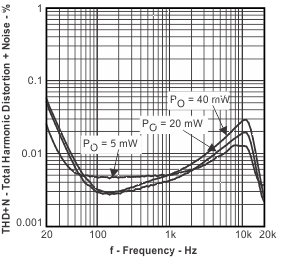SLOS488F November 2006 – March 2015 TPA6130A2
PRODUCTION DATA.
- 1 Features
- 2 Applications
- 3 Description
- 4 Simplified Schematic
- 5 Revision History
- 6 Pin Configuration and Functions
- 7 Specifications
- 8 Detailed Description
- 9 Applications and Implementation
- 10Power Supply Recommendations
- 11Layout
- 12Device and Documentation Support
- 13Mechanical, Packaging, and Orderable Information
7 Specifications
7.1 Absolute Maximum Ratings
over operating free-air temperature range (unless otherwise noted) (1)| MIN | MAX | UNIT | |||
|---|---|---|---|---|---|
| Supply voltage, VDD | –0.3 | 6.0 | V | ||
| VI | Input voltage | RIGHTINx, LEFTINx | –2.5 | 3.6 | V |
| SD, SCL, SDA | –0.3 | 7 | V | ||
| Output continuous total power dissipation | See the Thermal Information table | ||||
| TA | Operating free-air temperature range | –40 | 85 | °C | |
| TJ | Operating junction temperature range | –40 | 150 | °C | |
| Minimum Load Impedance | 12.8 | 12.8 | Ω | ||
(1) Stresses beyond those listed under Absolute Maximum Ratings may cause permanent damage to the device. These are stress ratings only, which do not imply functional operation of the device at these or any other conditions beyond those indicated under Recommended Operating Conditions. Exposure to absolute-maximum-rated conditions for extended periods may affect device reliability.
7.2 Handling Ratings
| MIN | MAX | UNIT | |||
|---|---|---|---|---|---|
| Tstg | Storage temperature range | –65 | 150 | °C | |
| V(ESD) | Electrostatic discharge | Human body model (HBM), per ANSI/ESDA/JEDEC JS-001, output pins(1) | –8 | 8 | kV |
| Human body model (HBM), per ANSI/ESDA/JEDEC JS-001, all other pins(1) | –3.5 | 3.5 | kV | ||
| Charged device model (CDM), per JEDEC specification JESD22-C101, all pins (2) | –1500 | 1500 | V | ||
(1) JEDEC document JEP155 states that 500-V HBM allows safe manufacturing with a standard ESD control process.
(2) JEDEC document JEP157 states that 250-V CDM allows safe manufacturing with a standard ESD control process.
7.3 Recommended Operating Conditions
over operating free-air temperature range (unless otherwise noted)| MIN | MAX | UNIT | |||
|---|---|---|---|---|---|
| VDD | Supply voltage | 2.5 | 5.5 | V | |
| VIH | High-level input voltage | SCL, SDA, SD | 1.3 | V | |
| VIL | Low-level input voltage | SCL, SDA | 0.6 | V | |
| SD | 0.35 | V | |||
7.4 Thermal Information
| THERMAL METRIC(1) | RTJ | YZH | UNIT | |
|---|---|---|---|---|
| 20 PINS | 16 PINS | |||
| RθJA | Junction-to-ambient thermal resistance | 34.8 | 75 | °C/W |
| RθJCtop | Junction-to-case (top) thermal resistance | 32.5 | 22 | |
| RθJB | Junction-to-board thermal resistance | 11.6 | 26 | |
| ψJT | Junction-to-top characterization parameter | 0.4 | 0.2 | |
| ψJB | Junction-to-board characterization parameter | 11.6 | 24 | |
| RθJCbot | Junction-to-case (bottom) thermal resistance | 3.1 | N/A | |
(1) For more information about traditional and new thermal metrics, see the IC Package Thermal Metrics application report, SPRA953.
7.5 Electrical Characteristics
TA = 25°C (unless otherwise noted)| PARAMETER | TEST CONDITIONS | MIN | TYP | MAX | UNIT | ||
|---|---|---|---|---|---|---|---|
| |VOS| | Output offset voltage | VDD = 2.5 V to 5.5 V, inputs grounded | 150 | 400 | μV | ||
| PSRR | Power supply rejection ratio | VDD = 2.5 V to 5.5 V, inputs grounded | –109 | –90 | dB | ||
| CMRR | Common mode rejection ratio | VDD = 2.5 V to 5.5 V | –68 | dB | |||
| |IIH| | High-level input current | VDD = 5.5 V, VI = VDD | SCL, SDA | 1 | µA | ||
| SD | 10 | ||||||
| |IIL| | Low-level input current | VDD = 5.5 V, VI = 0 V | SCL, SDA, SD | 1 | µA | ||
| IDD | Supply current | VDD = 2.5 V to 5.5 V, SD = VDD | 4 | 6 | mA | ||
| Shutdown mode, VDD = 2.5V to 5.5 V, SD = 0 V | 0.4 | 1 | µA | ||||
| SW Shutdown mode, VDD = 2.5V to 5.5 V, SWS = 1 | 25 | 75 | µA | ||||
| Both HP amps disabled, VDD = 2.5V to 5.5 V, SWS = 0, Charge Pump enabled, SD = VDD |
1.4 | 2.5 | mA | ||||
7.6 Operating Characteristics
VDD = 3.6 V , TA = 25°C, RL = 16 Ω (unless otherwise noted)| PARAMETER | TEST CONDITIONS | MIN | TYP | MAX | UNIT | ||
|---|---|---|---|---|---|---|---|
| PO | Output power | Stereo, Outputs out of phase, THD = 1%, f = 1 kHz, Gain = 0.1 dB |
VDD = 2.5V | 60 | mW | ||
| VDD = 3.6V | 127 | ||||||
| VDD = 5V | 138 | ||||||
| Bridge-tied load, THD = 1%, f = 1 kHz, Gain = 0.1 dB |
VDD = 2.5V | 110 | |||||
| VDD = 3.6V | 230 | ||||||
| VDD = 5V | 290 | ||||||
| THD+N | Total harmonic distortion plus noise | PO = 35 mW | f = 100 Hz | 0.0029% | |||
| f = 1 kHz | 0.0055% | ||||||
| f = 20 kHz | 0.0027% | ||||||
| kSVR | Supply ripple rejection ratio | 200 mVpp ripple, f = 217 Hz | –97 | –90 | dB | ||
| 200 mVpp ripple, f = 1 kHz | –93 | ||||||
| 200 mVpp ripple, f = 20 kHz | –76 | ||||||
| ΔAv | Gain matching | 1% | |||||
| Slew rate | 0.3 | V/µs | |||||
| Vn | Noise output voltage | VDD = 3.6V, A-weighted, Gain = 0.1 dB | 9 | µVRMS | |||
| fosc | Charge pump switching frequency | 300 | 400 | 500 | kHz | ||
| Start-up time from shutdown | 5 | ms | |||||
| Differential input impedance | See Figure 33 | ||||||
| SNR | Signal-to-noise ratio | Po = 35 mW | 98 | dB | |||
| Thermal shutdown | Threshold | 180 | °C | ||||
| Hysteresis | 35 | °C | |||||
| ZO | Tri-state HP output impedance | Hi-Z left and right bits set. HP amps disabled. DC value. | 25 | MΩ | |||
| CO | Output capacitance | 80 | pF | ||||
7.7 Timing Requirements(1)(2)
For I2C Interface Signals Over Recommended Operating Conditions (unless otherwise noted)| PARAMETER | TEST CONDITIONS | MIN | TYP | MAX | UNIT | |
|---|---|---|---|---|---|---|
| fSCL | Frequency, SCL | No wait states | 400 | kHz | ||
| tw(H) | Pulse duration, SCL high | 0.6 | μs | |||
| tw(L) | Pulse duration, SCL low | 1.3 | μs | |||
| tsu1 | Setup time, SDA to SCL | 300 | ns | |||
| th1 | Hold time, SCL to SDA | 10 | ns | |||
| t(buf) | Bus free time between stop and start condition | 1.3 | μs | |||
| tsu2 | Setup time, SCL to start condition | 0.6 | μs | |||
| th2 | Hold time, start condition to SCL | 0.6 | μs | |||
| tsu3 | Setup time, SCL to stop condition | 0.6 | μs | |||
(1) VPull-up = VDD
(2) A pull-up resistor ≤2 kΩ is required for a 5 V I2C bus voltage.
 Figure 1. SCL and SDA Timing
Figure 1. SCL and SDA Timing
 Figure 2. Start and Stop Conditions Timing
Figure 2. Start and Stop Conditions Timing
7.8 Typical Characteristics
C(PUMP, DECOUPLE, ,BYPASS, CPVSS) = 1 μF, CI = 2.2µF.All THD + N graphs taken with outputs out of phase (unless otherwise noted).
Table 1. Table of Graphs
| FIGURE | ||
|---|---|---|
| Total harmonic distortion + noise | vs Output power | Figure 3–Figure 8 |
| Total harmonic distortion + noise | vs Frequency | Figure 9–Figure 22 |
| Supply voltage rejection ratio | vs Frequency | Figure 23–Figure 25 |
| Common mode rejection ratio | vs Frequency | Figure 26, Figure 27 |
| Output power | vs Load | Figure 28, Figure 29 |
| Output voltage | vs Load | Figure 30, Figure 31 |
| Power Dissipation | vs Output power | Figure 32 |
| Differential Input Impedance | vs Gain | Figure 33 |
| Shutdown time | Figure 46 | |
| Startup time | Figure 47 | |
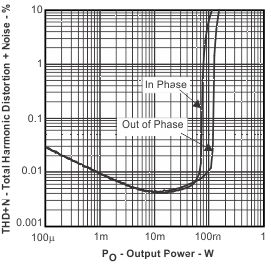
| RL = 16 Ω | Gain = 6.1 dB | fIN = 1 kHz |
| BTL |
vs Output Power
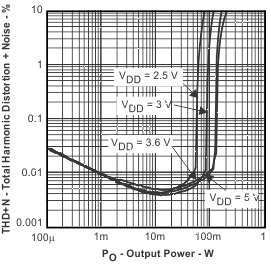
| RL = 16 Ω | Gain = 0.1 dB | fIN = 1 kHz |
| Stereo |
vs Output Power
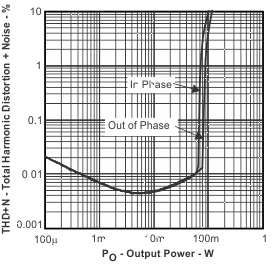
| RL = 32 Ω | Gain = 0.1 dB | VDD = 3.6 |
| fIN = 1 kHz | Stereo |
vs Output Power
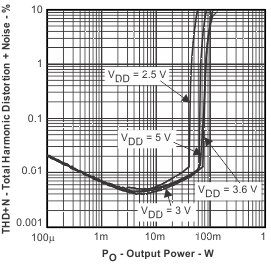
| RL = 32 Ω | Gain = 0.1 dB | fIN = 1 kHz |
| Stereo |
vs Output Power
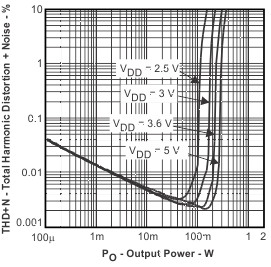
| RL = 16 Ω | Gain = 6.1 dB | fIN = 1 kHz |
| BTL |
vs Output Power
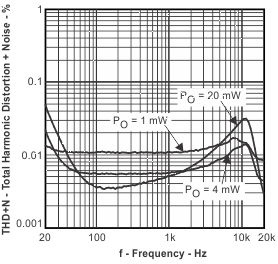
| RL = 16 Ω | VDD = 2.5 V | Gain = 0.1 dB |
| Stereo |
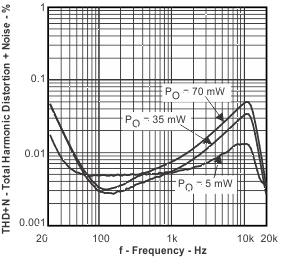
| RL = 16 Ω | VDD = 3.6 V | Gain = 0.1 dB |
| Stereo |
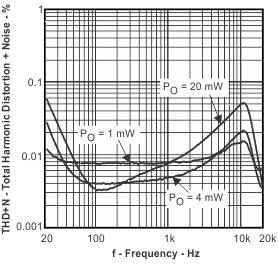
| RL = 32 Ω | VDD = 2.5 V | Gain = 0.1 dB |
| Stereo |
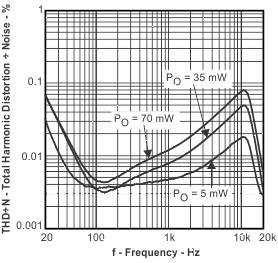
| RL = 32 Ω | VDD = 3.6 V | Gain = 0.1 dB |
| Stereo |
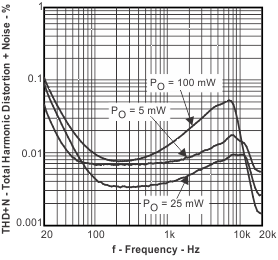
| RL = 16 Ω | VDD = 2.5 V | Gain = 6.1 dB |
| BTL |
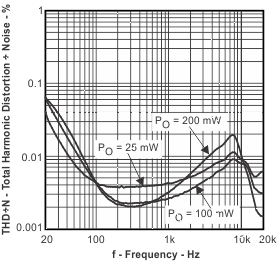
| RL = 16 Ω | VDD = 5 V | Gain = 6.1 dB |
| BTL |
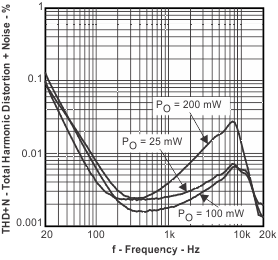
| RL = 32 Ω | VDD = 3.6 V | Gain = 6.1 dB |
| BTL |
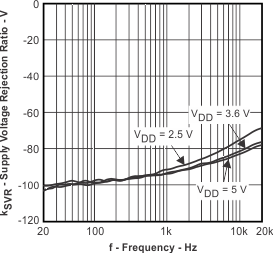
| RL = 16 Ω | Cp = 1 µF | Gain = 0.1 dB |
| Stereo |
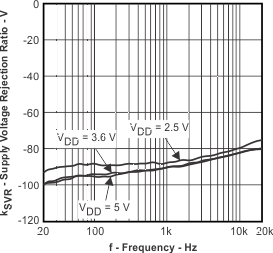
| RL = 16 Ω | Cp = 1 µF | Gain = 6.1 dB |
| BTL |
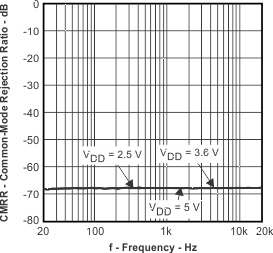
| RL = 16 Ω | CI = 2.2 µF | Gain = 6.1 dB |
| BTL |
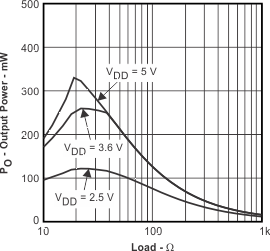
| fIN = 1 kHz | Gain = 6.1 dB | THD+N = 1% |
| BTL |
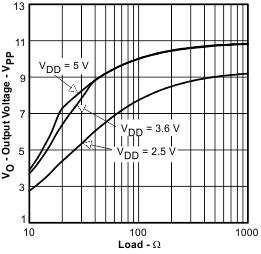
| fIN = 1 kHz | Gain = 6.1 dB | THD+N = 1% |
| BTL |
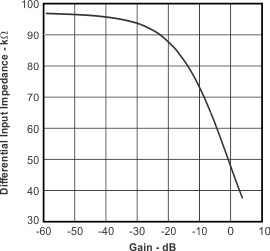
| VDD = 3.6 V |
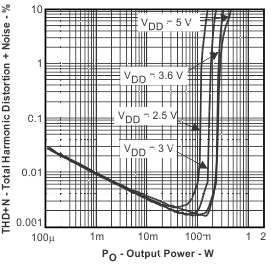
| RL = 32 Ω | Gain = 6.1 dB | fIN = 1 kHz |
| BTL |
vs Output Power
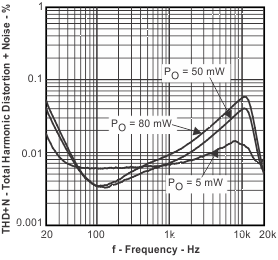
| RL = 16 Ω | VDD = 5 V | Gain = 0.1 dB |
| Stereo |
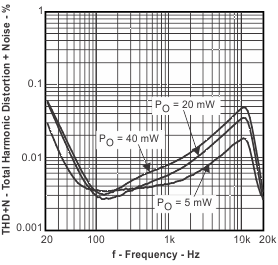
| RL = 32 Ω | VDD = 3 V | Gain = 0.1 dB |
| Stereo |
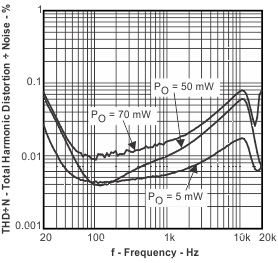
| RL = 32 Ω | VDD = 5 V | Gain = 0.1 dB |
| Stereo |
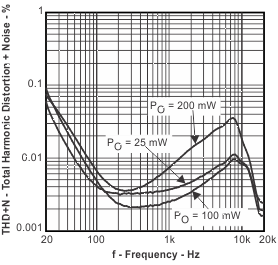
| RL = 16 Ω | VDD = 3.6 V | Gain = 6.1 dB |
| BTL |
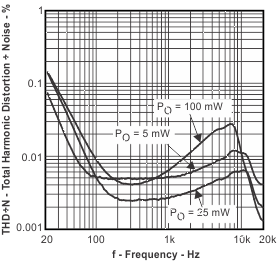
| RL = 32 Ω | VDD = 2.5 V | Gain = 6.1 dB |
| BTL |
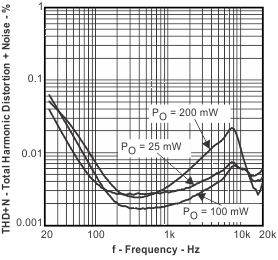
| RL = 32 Ω | VDD = 5 V | Gain = 6.1 dB |
| BTL |
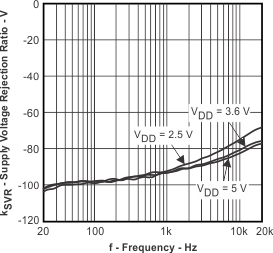
| RL = 32 Ω | Cp = 1 µF | Gain = 0.1 dB |
| Stereo |
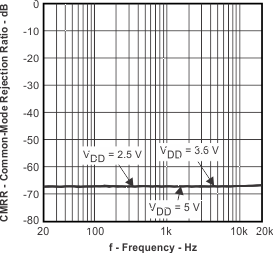
| RL = 16 Ω | CI = 2.2 µF | Gain = 0.1 dB |
| Stereo |
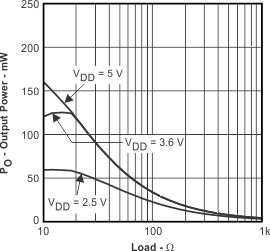
| fIN = 1 kHz | Gain = 0.1 dB | THD+N = 1% |
| Stereo |
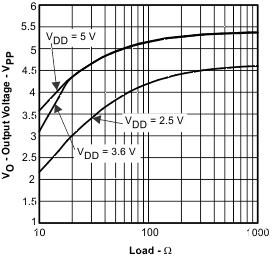
| fIN = 1 kHz | Gain = 0.1 dB | THD+N = 1% |
| Stereo |
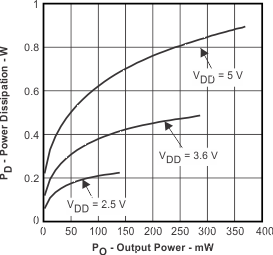
| RL = 16 Ω | Gain = 0.1 dB | Stereo |
